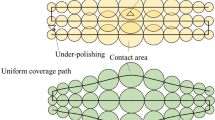Abstract
In this paper, a method is proposed to generate scanning paths to be used in automated abrasive waterjet polishing of free-form surfaces. This method is able to produce trajectories with constant offset distance between curves on surfaces with holes and complex boundaries without reconfiguration of their triangular mesh model. For this, the particular requirements of this polishing technique to be kept along the path are investigated. Next, a reference curve is obtained and using geodesic distances in specific directions, the adjacent offset curves are found. Finally, if needed, the main trajectory is divided into a set of continuous sub-trajectories. By defining two indices, the effect of the shape of the surface and the configuration of the generated path on the uniformity of the distribution of the waterjet is evaluated. Through several examples, it is shown that the method can effectively generate scanning paths adapted to the requirements of this technique.
Similar content being viewed by others
References
Mao TF, Yang SC, Tsai FC, Hung JC, Yan BH (2010) Experimental investigation of abrasive jet polishing on the free-form machined surfaces of skd61 mold steel using sic particles. Mater Manuf Process 25(9):965–973
Shafiei N, Getu H, Sadeghian A, Papini M (2009) Computer simulation of developing abrasive jet machined profiles including particle interference. J Mater Process Technol 209(9):4366– 4378
Li Z, Li S, Dai Y, Peng X (2010) Optimization and application of influence function in abrasive jet polishing. Appl Opt 49(15):2947–2953
Atkar PN, Conner DC, Greenfield A, Choset H, Rizzi AA (2009) Hierarchical segmentation of piecewise pseudoextruded surfaces for uniform coverage. IEEE Trans Autom Sci Eng (USA) 6:107–120
Feng-yun L, Tian-sheng L (2005) Development of a robot system for complex surfaces polishing based on cl data. Int J Adv Manuf Technol 26(9–10):1132–1137
Hauth S, Richterich C, Glasmacher L, Linsen L (2011) Constant cusp toolpath generation in configuration space based on offset curves. Int J AdvManuf Technol 53(1–4):325–338
Nagata F, Watanabe K, Izumi K (2001) Furniture polishing robot using a trajectory generator based on cutter location data. In: Proceedings ICRA. IEEE International Conference on Roboticsand Automation, vol 1, pp 319–324
Park SC, Chung YC, Choi BK (2003) Contour-parallel offset machining without tool-retractions. Comput Aided Des 35(9):841–849
Ryuh B, Park SM, Pennock GR (2006) An automatic tool changer and integrated software for a robotic die polishing station. Mech Mach Theory 41(4):415–432
Sheng W, Chen H, Xi N, Chen Y (2005) Tool path planning for compound surfaces in spray forming processes. IEEE Trans Autom Sci Eng 2(3):240–249
Yang DCH, Chuang JJ, Han Z, Ding S (2003) Boundary-conformed toolpath generation for trimmed free-form surfaces via coons reparametrization. J Mater Process Technol 138:138–144
Yuwen S, Dongming G, Zhenyuan J, Haixia W (2006) Iso-parametric tool path generation from triangular meshes for free-form surface machining. Int J Adv Manuf Technol 28(7–8):721–726
Tam HY (1999) Toward the uniform coverage of surfaces by scanning curves. Comput Aided Des 31(9):585–596
Tam HY, Lui OCH, Mok ACK (1999) Robotic polishing of free-form surfaces using scanning paths. J Mater Process Technol 95(1–3):191–200
Tsai MJ, Chang JL, Haung JF (2005) Development of an automatic mold polishing system. IEEE Trans Autom Sci Eng 2(4):393–397
Surazhsky V, Surazhsky T, Kirsanov D, Gortler SJ, Hoppe H (2005) Fast exact and approximate geodesics on meshes. ACM Trans Graph 24(3):553–560
Kout A, Muller H (2010) A framework for the generation of distance field based curves on triangular mesh surfaces for nc manufacturing. Tech rep, Department of Computer Science, Technische Universitt Dortmund
Bommes D, Kobbelt L (2007) Accurate computation of geodesic distance fields for polygonal curves on triangle meshes. VMV:151–160
Yuen P, Mokhtarian F, Khalili N, Illingworth J (2000) Curvature and torsion feature extraction from free-form 3-d meshes at multiple scales. IEE Proc Vis Image Signal Process 147(5):454–462
Xin SQ, Ying X, He Y (2012) Constant-time all-pairs geodesic distance query on triangle meshes. In: Proc. - I3D: ACM SIGGRAPH Symp. Interact, vol 3D. Graph. Games, Costa Mesa, pp 31–38
Patrikalakis N, Bardis L (1989) Offsets of curves on rational b-spline surfaces. Eng Comput 5:39–46
Patrikalakis NM, Maekawa T (2002) Shape Inter-rogation for Computer Aided Design and Manufacturing. Springer
Mitchell JSB, Mount DM, Papadimitriou CH (1987) The discrete geodesic problem. SIAM J Comput 16(4):647–668
Galceran E, Carreras M (2013) A survey on coverage path planning for robotics. Rob Autom Syst 61(12):1258–1276
Dong C, Wang G (2005) Curvatures estimation on triangular mesh. JZUS:128–136
Szilvasi-Nagy M (2006) About curvatures on triangle meshes. KoG 10:13–18
Author information
Authors and Affiliations
Corresponding author
Rights and permissions
About this article
Cite this article
Khakpour, H., Birglen, L. & Tahan, SA. Uniform scanning path generation for abrasive waterjet polishing of free-form surfaces modeled by triangulated meshes. Int J Adv Manuf Technol 77, 1167–1176 (2015). https://doi.org/10.1007/s00170-014-6504-1
Received:
Accepted:
Published:
Issue Date:
DOI: https://doi.org/10.1007/s00170-014-6504-1



